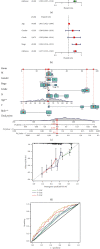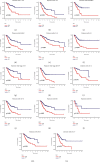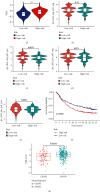Identification of a Metabolic Reprogramming-Associated Risk Model Related to Prognosis, Immune Microenvironment, and Immunotherapy of Stomach Adenocarcinoma
- PMID: 36185624
- PMCID: PMC9519326
- DOI: 10.1155/2022/7248572
Identification of a Metabolic Reprogramming-Associated Risk Model Related to Prognosis, Immune Microenvironment, and Immunotherapy of Stomach Adenocarcinoma
Abstract
Stomach adenocarcinoma (STAD) is one of the most common malignant digestive tumors. Metabolic reprogramming is an essential feature of tumorigenesis. The roles of metabolic reprogramming in STAD patients were investigated to explore the tumor immune microenvironment (TME) and potential therapeutic strategies. STAD samples' transcriptomic and clinical data were collected from The Cancer Genome Atlas (TCGA) set and the GSE84437 set. The signature based on the metabolism-related genes (MRGs) was built using the Cox regression model to predict prognosis in STAD. Notably, this MRG-based signature (MRGS) accurately predicted STAD patients' clinical survival in multiple datasets and could serve as an indicator independently. STAD patients with high scores on the MRGS were eligible for generating a type I/II interferon (IFN) response, according to a complete examination of the link between the MRGS and TME. Tumor Immune Dysfunction and Exclusion (TIDE) and immunophenoscore (IPS) analyses revealed that STAD patients with different MRGS scores had different reactions to immunotherapy. Consequently, assessing the pattern of these MRGs increases the understanding of TME features in STAD, hence directing the development of successful immunotherapy regimens.
Copyright © 2022 Yan Zhao et al.
Conflict of interest statement
The authors declare that the research was conducted in the absence of any commercial or financial relationships that could be construed as potential conflicts of interest.
Figures









References
-
- Katai H., Ishikawa T., Akazawa K., et al. Five-year survival analysis of surgically resected gastric cancer cases in Japan: a retrospective analysis of more than 100, 000 patients from the nationwide registry of the Japanese Gastric Cancer Association (2001-2007) Gastric Cancer . 2018;21(1):144–154. doi: 10.1007/s10120-017-0716-7. - DOI - PubMed
LinkOut - more resources
Full Text Sources

